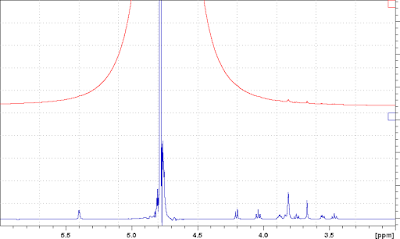The previous post described how a combination of gradients and pulses can be used to help reduce artifacts in NMR spectra. Adding a selective pulse to that sequence enables solvent signals to be excluded. This technique, sometimes known as excitation sculpting, is described below.
The figure below follows the same conventions as the figure in the previous post. The top row shows an NMR tube viewed from the side, while the bottom row shows the same tube viewed from the top looking down the z-axis. The arrows in the sample tube represent the magnetisation at different positions within the sample solution. The gray arrows are the bulk magentisation and are darker for nuclei closer to the top of the sample tube. The blue arrows represent magnetisation of the water.
At the start of the experiment the magnetisation of all nuclei is aligned along the z-axis, pointing upwards. After a 90o pulse along the x-axis the magnetisation is rotated onto the y-axis. Applying a gradient along the z-axis for a time Δ dephases the bulk magnetisation because the magnetic field at the top of the tube is stronger than that at the bottom.
Up until this point the sequence of pulses is the same as in the previous post. The addition that enables solvent suppression is the introduction of a water selective 180o pulse along the x-axis. This pulse inverts just the water resonance. The figure depicts the selectively inverted water nuclei as small blue arrows pointing away from the bulk magnetization vectors.
Continuing with the rest of the original sequence, a 180o pulse along the x-axis inverts both the bulk magnetisation and the selectively excited water resonance so that they are still pointing in opposite directions. Applying a second gradient pulse along the z-axis brings the bulk magnetisation vectors back into alignment, but the magnetisation of the selectively excited water nuclei spreads out even further, minimising the signal that can be detected from them.
In practice, the "gradient-selective 180-180-gradient" sequence is executed twice to get the best signal suppression. The figure below shows a normal 1D 1H spectrum of 2mM sucrose in 90% H2O/10% D2O at the top in red, and an excitation sculpting spectrum of the same sample at the bottom in blue. Both spectra were recorded with the same relaxation delay and number of scans, but the red spectrum is scaled up by a factor of 16 to show the sucrose peaks. For the excitation sculpting spectrum, a 2 ms square pulse was used to selectively excite the water resonance.
The dramatic reduction of the water peak in the excitation sculpting spectrum is obvious. In this experiment the selective pulse was applied at the center of the spectrum, but it is also possible to apply the selective pulse at any position in the spectrum. Taking advantage of this allows two peaks to be suppressed simultaneously, which is useful if using methanol as a solvent. An off-resonance selective pulse suppresses one peak by excitation sculpting and presaturation at the carrier frequency suppresses the second.
References
1. T.-L. Hwang and A.J. Shaka
"Water Suppression That Works. Excitation Sculpting Using Arbitrary Wave-Forms and Pulsed-Field Gradients"
J. Magn. Reson. Series A 1995 112:275-279.



No comments:
Post a Comment